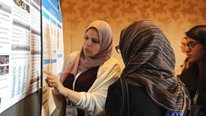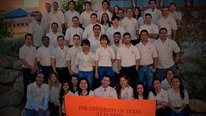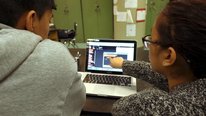- Sarah Dunton
- ECEP Alliance Manager
- Expanding Computing Education Pathways (ECEP)
- http://expandingcomputing.cs.umass.edu/
- University of Massachusetts Amherst
- W. ADRION
- https://people.cs.umass.edu/~adrion/
- Professor Emeritus
- Expanding Computing Education Pathways (ECEP)
- http://expandingcomputing.cs.umass.edu/
- ECEP Alliance, University of Massachusetts Amherst
- Barbara Ericson
- http://barbara-ericson.strikingly.com
- Senior Research Scientist
- Expanding Computing Education Pathways (ECEP)
- http://expandingcomputing.cs.umass.edu/
- ECEP Alliance
- Julia Fan
- Expanding Computing Education Pathways (ECEP)
- http://expandingcomputing.cs.umass.edu/
- University of Massachusetts Amherst
- Carol Fletcher
- https://www.linkedin.com/in/carol-fletcher-20740511?trk=nav_responsive_tab_profile
- Deputy Director
- Expanding Computing Education Pathways (ECEP)
- http://expandingcomputing.cs.umass.edu/
- University of Texas at Austin
- Vinh Luong
- CA Coordinator
- Expanding Computing Education Pathways (ECEP)
- http://expandingcomputing.cs.umass.edu/
- University of California, Irvine
Public Discussion
Continue the discussion of this presentation on the Multiplex. Go to Multiplex












Julie Steimle
Any chance you will expand to Ohio?
Sarah Dunton
ECEP Alliance Manager
Julie,
The PIs and CoPIs have discussed expansion to new states. It’s great to know that you are interested in the model. For now we are gathering a list of interested states as we consider the possibility of growth. If you haven’t already checked out the ECEP website at http://expandingcomputing.cs.umass.edu/ , please do. There are resources posted that you and your state can take advantage of now.
Where do you see Ohio in the 4 stages of the ECEP model? I’d like to learn a little more about the current CS landscape there.
Feel free to email me directly if you have additional questions.
Julie Steimle
Ohio does allow computer science to count as a math credit, which helps. However, the most rigorous computer science courses are still only found in schools that serve wealthier populations. It would be nice to expand access to all students.
Carol Fletcher
Deputy Director
Texas would love to talk with Ohio about how we can help grow CS teachers. We’ve just launched an online course in EdX to help teachers pass the Texas certification exam.
Vinh Luong
CA Coordinator
Julie – Likewise, California would also love to talk with Ohio to explore ways to develop/strengthen new and current CS teachers and increase access to CS education opportunities for all students.
Barbara Ericson
Senior Research Scientist
Another option for teacher professional development is to use a blended model. Our research group at Georgia Tech has been creating a free ebook to help teachers without any prior programming experience learn how to teach the programming and data part of the CS Principles curriculum. See http://tinyurl.com/TeacherCSP for the teacher version of this ebook and http://tinyurl.com/StudentCSP for the companion student version.
Katie Rich
Curriculum Developer
Hi Sarah and colleagues,
I like the four-step model that you outline for reform.
Could you describe some strategies that your participating states have used to get started on Step 1? Does your project have a discussion board or other online meeting place that might help people find others from their states that are interested in this issue? Have states relied mostly on asynchronous online discussions — easier to manage when many people are involved — or have they found in-person summits to be critical to getting started?
W. ADRION
Professor Emeritus
Identifying leaders and change agents varies in each state. They are likely to be in higher ed, state ed departments, industry and industry associations, CSTA chapters, STEM teacher orgs, superintendent orgs, CUE (computer using educators) orgs, non-profits, etc..Many state-based folks have met at key national meetings: Jan Cuny’s NSF PI meetings (BPC, CE-21, STEM+C), NCWIT, or CSTA.
Organizing them into a leadership group also varies. In some states CSTA chapters have been been the organizing focus (CT). In other states, industry groups (MassCAN in MA, ITology in SC) are the catalysts, in others higher education/industry/government groups (ACCESS in CA, TACSE in TX), and in some groups or individuals with NSF, DoEd, or NASA funding, etc. (AL, NH, UT, MD). In ECEP states, some groups have restructured, combined, etc. e.g., MD, UT, AL started as higher ed grants, but are now statewide with schools and depts of Ed (and code.org in AL and UT). MA and SC started as industry groups but now include higher education, dept of Ed, schools, teachers, etc.). ECEP tries to help match make, by suggesting possible contacts.
The bottom line is someone needs to step up and start organizing.
Carol Fletcher
Deputy Director
In Texas, our very first event was a partnership with the Austin Chamber of Commerce to host a small meeting of interested folks from industry, public schools, higher ed and policy to help us first define the problem and quantify the current state of CS education. It didn’t take a ton of $$$ and we had less than 20 people but it resulted in the publication of a white paper that then gave us a framework for future work and discussions. The vast majority of people from all of those fields had no idea how little was being done in CS. The white paper can be found at http://www.thetrc.org/computer-science-resources/
Irene Lee
Research Scientist
Hello, I am curious about how you plan to choose the next states to expand to as part of the ECEP effort. Is there a rubric or strategy for doing so?
Mark Guzdial
Hi Irene,
We did have a rubric, and it flows from the video. For example, we were looking for states that had a leader (e.g., someone who would participate in the ECEP Cohort, who would reach across sectors) and a cross-sector organizing/advising committee. Our strategy was to focus on states in which ECEP could be a catalyst — that we could help to spur on reform to broaden and improve access to computing education in a state.
Irene Lee
Research Scientist
One concern is that the “most functional” states will move forward (“rich get richer”) using this strategy. But I realize that a state leader must emerge before you can help a state move forward.
Barbara Ericson
Senior Research Scientist
Yes, it is true that we are looking to add the “most functional” states. We only have a small amount of funding so we are trying to make the most of the funding by working with states that are ready to make progress. We can’t do much in a state if there isn’t a group or at least a leader to start work on the problems.
Beverly Woolf
Dear Sarah and Rick,
This video is great. Thanks for preparing it.
ECEP is a rich and complex concept. The steps you have identified help to clarify the activities and the animations in the video provide nice analogies to convey what the project is doing.
Well done. Congratulations
Beverly Woolf
Sarah Dunton
ECEP Alliance Manager
Thank you for the feedback Beverly. With the growth of CS education and CS for All, states are seeking ways to coordinate conversations with K-12, higher education and industry. The current 11 ECEP states and the territory of Puerto Rico are finding the ECEP model helpful. We hope this video, and all of our materials at http://expandingcomputing.cs.umass.edu/ , will help new states to launch their CS education initiatives.
Jennifer Michalek
Connecticut already had step 1 complete when we joined ECEP. However, the group lacked direction and our partnership with ECEP has provided us with the opportunity to reflect on our goals and create a plan to accomplish those goals. Although the process is slow, we are making steps forward to expand Computer Science in schools across our state.
Dawn Chipman
Great video!
Sarah Dunton
ECEP Alliance Manager
Thanks Dawn.
Katie Rich
Curriculum Developer
I’m interested in hearing more about the continuum you describe in Step 2. What are different ways you’d describe progress along this continuum? Number of schools offering CS? Number of trained teachers? Amount of discussion happening?
I’d be curious to hear how anyone who has looked at CS in their state would describe their position on the continuum.
Mark Guzdial
Hi Katie,
Great question! I know what the end goal looks like: All students have access to high-quality computing education, with teachers and (multiple) classes in every school, and participation in those classes looks much more like the demographics of the general population than CS classes do today. We recently wrote a Blog@CACM post on where the ECEP Cohort states are in progress towards this goal: http://cacm.acm.org/blogs/blog-cacm/198790-stat.... I blog regularly on how we’re doing in movement towards these goals, including this post on the latest data from Georgia: https://computinged.wordpress.com/2016/03/31/st...
- Mark
Steve Bean
Sarah,I’m glad that I happened across your video. It’s so refreshing to see a high-level policy reform initiative in among all the education demonstration projects. We’re based out of agrarian Watsonville and Salinas CA:
http://stemforall2016.videohall.com/presentatio...
Can you tell me how we connect with what your initiative is doing here in CA? We have good relationships with CA Assemblymember Luis Alejo’s office, the Panetta Institute and White House Senior Policy Advisor (and Watsonville native son) Rafael Lopez but haven’t heard of your initiative.
Sarah Dunton
ECEP Alliance Manager
Steve,
We’re glad you found us too. Thank you for the feedback. One of our goals is to make all of our resources and contacts easily accessible. We don’t want people to feel like they need to start at zero. The CA contacts and information about CA can be found at: http://expandingcomputing.cs.umass.edu/california
One of the co-presenters on this video is Vinh Luong. He is a great first contact to reach out to. I will keep you in our database of people interested in learning more about our work.
Jill Denner
I just met Vinh at the NCWIT Summit yesterday! We will definitely reach out to him, and to Julie Flapan. We need to better connect our work with state-wide efforts.
Vinh Luong
CA Coordinator
Hi Jill,
It was a pleasure #NESTworking with you yesterday at the K-12 Alliance session. I would love to learn more about the Digital NEST and your research on the integration of CS Education in informal settings. Let’s arrange a time to chat, and maybe explore opportunities to collaborate.
Ramesh Sitaraman
Great work by ECEP.
Evan Korth
Clinical Professor
This is a fantastic effort and great video. We have made quite a bit of progress in NYC where we have a state sized school system. From our experience I think the four steps are a great framework. Do you have a repository of best practices for each of the four steps?
Have you reached out to any organizations that could help fund replication of your best practices around the country?
Mark Guzdial
Thanks, Evan! We’re trying to figure out how to communicate what is happening with our ECEP cohort. The problem is figuring out what’s the right unit to share — what’s a “practice”? What would we put in the repository? States are so very different from one another. We find that our cohort takes things from each other that we might not have predicted as a useful nugget, e.g., a survey to teachers from this state, a CS teacher incentive program from that state. We might have to document these as case studies.
Richard Ladner
ECEP rocks. Keep up the great work.
W. ADRION
Professor Emeritus
Thanks Richard!
Further posting is closed as the showcase has ended.